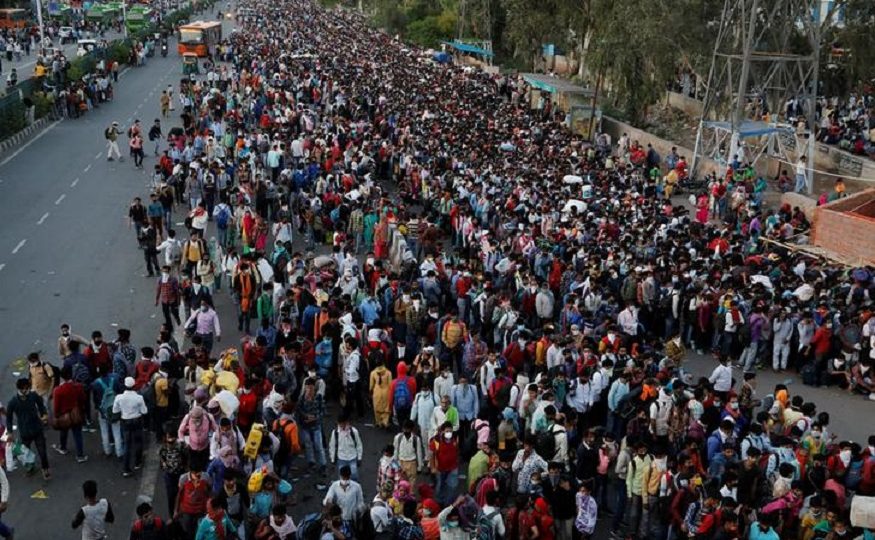Kuffir
A few notes on the recent budget, and other events, to examine how they promote/subvert Babasaheb’s ideals of ‘liberty, equality and fraternity’.
~
One of Gaddar’s popular songs goes something like:
India is a land of good fortune,
There is no dearth of any (natural) wealth here,
There are fields that yield golden harvests,
And rivers that are immortal,
But like the saying goes, squalor reigns everywhere in the land—
Although you’ve everything you need (to fulfill your destiny)—
Because Shani dances on your son-in-law’s tongue!
Through the Covid era and earlier, it’d seem Modi never failed to change his suits twice or thrice a day. What does it matter, as this India Today report says1, if over 25 million, or half of all Indian factory workers, had lost their jobs in manufacturing; services, the largest contributor to GDP, had also taken an immeasurably severe beating—what does it matter? As I had said earlier, the lockdown drove more than a third of India’s workforce out of work2. It had also shaved off around a quarter of the overall GDP itself, according to various estimates.
But Modi’s confidence can look away from any lockdown damage, in complete insouciance, and play with peacocks etc. Like his bête noire, Nehru, he has been chosen as the country’s Supreme Son-In-Law. Neither had ever done an honest day’s labour to earn his rozi roti—one as part of the Brahmin aristocracy and the other as the same aristocracy’s most energetic karyakarta in recent decades—how do the travails of the Bahujan laboring majority matter to him?
~
The official figure of the Covid death toll in India is around half a million. But according to a study by the Centre for Global Health Research at the University of Toronto, the actual number of mortalities could be six times that number. Or 3.2 million3. Or several times more than the combined number of deaths due to all the wars with external ‘enemies’—with Pakistan, China and misadventures in Sri Lanka—and ‘internal’ wars—conducted on freedom fighters and revolutionaries in Kashmir, Northeastern states, Punjab, the Adivasis in Dandakaranya etc— and the major natural calamities—cyclones, earthquakes etc— that hit India in the last 75 years!
There have been other studies, research which also came up with estimates much higher than the official figures. The import of all these estimates is this: that Covid in India is/was an epochal catastrophe. Ideally, that should warrant a complete shift in a country’s direction, priorities and thinking, to put it mildly.
If India wishes to survive, it needs to think like major European economies after the Second World War. Or Russia, or Japan. Or even Iraq or Iran after the many wars in the past three decades. Or China after all the massive tragedies it had suffered for most of the 20th century until the 70s. India needs to think very hard because it has barely survived Covid, thanks to largely not looking at the dark world of the Bahujan majority, or the informal economy.
Covid was/is about healthcare or lack of it. The health of citizens had become an imperative function of all modern states across the world in the last one century. And you’d think at least Covid would have knocked some sense into the Indian state’s head. But no.
The poorest, the most war ravaged, the least democratic and the worst of failing states: the Indian state spends overwhelmingly less than all of them, with a handful of exceptions.
In almost 90% of countries across the globe, government healthcare expenditure on every individual’s health is more than in India. From Angola to Australia to Argentina, Egypt to Estonia to Equatorial Guinea, Sweden to South Africa to Serbia. It’s not just Western Europe and North America (where it is 50-100 times more than in India, on average), it is also in Middle East and North, Sub-Saharan Africa, Latin America and so on: they all spend 5-20 times more than India, according to the World Bank, in dollar terms.4
The world average is 671 dollars. The Indian government’s spend is around 20 dollars, or 1/33th the world average.
The key to understand whether any state is medieval or modern or pure sanatani (or pre-historic) is to compare how much a government spends on every citizen or subject’s health. To catch up with the world, the Indian government has to spend over 33 times what it does now on health. It took a giant revolutionary step in that direction a few days ago through the Union Budget 2022-23 by increasing the allocation to healthcare by a gigantic 0.2% over the previous year’s revised budget!5
It’s an impossible task, you might say, more than sisyphean. But there is a silver lining: no member of the Brahmin-upper caste ruling class has ever let that thought (of equal healthcare for even the Bahujans) even enter their imagination. Think of it this way: it becomes a task only if someone plans to work on it, no? No one did in the past 75 years.
It is utterly foolish to imagine what didn’t happen in 1947, in Nehru’s time, to be accomplished now, in Modi’s time. Or in the next 100 or 1000 years. It isn’t a question of who’s the bigger Shani-in-law—Nehru or Modi or any of those who came after Nehru and before Modi. It’s a question of who does the Indian state represent, whose interests are its only interests. In simpler terms, who does Shani work for? The Devtas, or the Brahmins-upper castes, in even simpler terms. That’s India’s founding contradiction.
For the suffering Bahujan majority, especially millions of whom had to walk home during the first lockdown, this harsh truth should have become plainer during the last couple of years: that they need to fend for themselves. They can’t ever depend on any Devtas.
~
Notes
1. https://www.indiatoday.in/business/story/explained-why-india-s-economy-needs-a-manufacturing-push-1846038-2021-08-27
and
https://www.indiatoday.in/business/story/reality-check-how-coronavirus-crushed-dreams-of-millions-in-rural-india-1712070-2020-08-17
2. https://www.goethe.de/ins/gb/en/kul/ser/arc/zei/22008456.html
3. https://indianexpress.com/article/india/india-Covid-death-toll-could-be-higher-7712308/
4. https://data.worldbank.org/indicator/SH.XPD.GHED.PC.CD
5. https://www.moneycontrol.com/news/trends/health-trends/union-budget-2022-health-sector-sees-45-drop-in-proposed-expenses-allocation-up-0-2-8021471.html
~
Picture courtesy: the internet.










